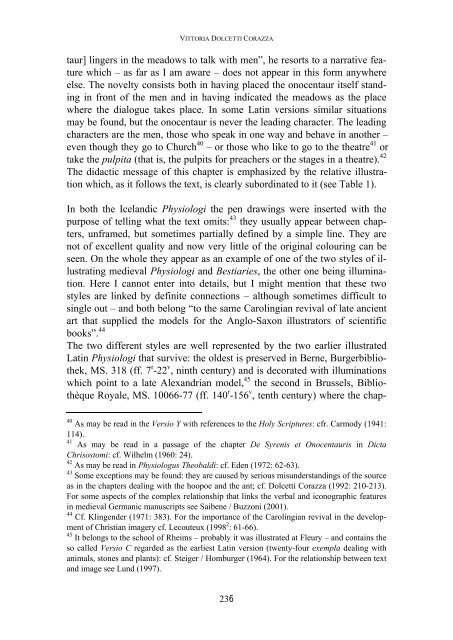Crossing paths in the Middle Ages: the Physiologus in Iceland - Lear
Crossing paths in the Middle Ages: the Physiologus in Iceland - Lear
Crossing paths in the Middle Ages: the Physiologus in Iceland - Lear
You also want an ePaper? Increase the reach of your titles
YUMPU automatically turns print PDFs into web optimized ePapers that Google loves.
VITTORIA DOLCETTI CORAZZA<br />
taur] l<strong>in</strong>gers <strong>in</strong> <strong>the</strong> meadows to talk with men”, he resorts to a narrative feature<br />
which – as far as I am aware – does not appear <strong>in</strong> this form anywhere<br />
else. The novelty consists both <strong>in</strong> hav<strong>in</strong>g placed <strong>the</strong> onocentaur itself stand<strong>in</strong>g<br />
<strong>in</strong> front of <strong>the</strong> men and <strong>in</strong> hav<strong>in</strong>g <strong>in</strong>dicated <strong>the</strong> meadows as <strong>the</strong> place<br />
where <strong>the</strong> dialogue takes place. In some Lat<strong>in</strong> versions similar situations<br />
may be found, but <strong>the</strong> onocentaur is never <strong>the</strong> lead<strong>in</strong>g character. The lead<strong>in</strong>g<br />
characters are <strong>the</strong> men, those who speak <strong>in</strong> one way and behave <strong>in</strong> ano<strong>the</strong>r –<br />
even though <strong>the</strong>y go to Church 40 – or those who like to go to <strong>the</strong> <strong>the</strong>atre 41 or<br />
take <strong>the</strong> pulpita (that is, <strong>the</strong> pulpits for preachers or <strong>the</strong> stages <strong>in</strong> a <strong>the</strong>atre). 42<br />
The didactic message of this chapter is emphasized by <strong>the</strong> relative illustration<br />
which, as it follows <strong>the</strong> text, is clearly subord<strong>in</strong>ated to it (see Table 1).<br />
In both <strong>the</strong> <strong>Iceland</strong>ic Physiologi <strong>the</strong> pen draw<strong>in</strong>gs were <strong>in</strong>serted with <strong>the</strong><br />
purpose of tell<strong>in</strong>g what <strong>the</strong> text omits: 43 <strong>the</strong>y usually appear between chapters,<br />
unframed, but sometimes partially def<strong>in</strong>ed by a simple l<strong>in</strong>e. They are<br />
not of excellent quality and now very little of <strong>the</strong> orig<strong>in</strong>al colour<strong>in</strong>g can be<br />
seen. On <strong>the</strong> whole <strong>the</strong>y appear as an example of one of <strong>the</strong> two styles of illustrat<strong>in</strong>g<br />
medieval Physiologi and Bestiaries, <strong>the</strong> o<strong>the</strong>r one be<strong>in</strong>g illum<strong>in</strong>ation.<br />
Here I cannot enter <strong>in</strong>to details, but I might mention that <strong>the</strong>se two<br />
styles are l<strong>in</strong>ked by def<strong>in</strong>ite connections – although sometimes difficult to<br />
s<strong>in</strong>gle out – and both belong “to <strong>the</strong> same Carol<strong>in</strong>gian revival of late ancient<br />
art that supplied <strong>the</strong> models for <strong>the</strong> Anglo-Saxon illustrators of scientific<br />
books”. 44<br />
The two different styles are well represented by <strong>the</strong> two earlier illustrated<br />
Lat<strong>in</strong> Physiologi that survive: <strong>the</strong> oldest is preserved <strong>in</strong> Berne, Burgerbiblio<strong>the</strong>k,<br />
MS. 318 (ff. 7 r -22 v , n<strong>in</strong>th century) and is decorated with illum<strong>in</strong>ations<br />
which po<strong>in</strong>t to a late Alexandrian model, 45 <strong>the</strong> second <strong>in</strong> Brussels, Bibliothèque<br />
Royale, MS. 10066-77 (ff. 140 r -156 v , tenth century) where <strong>the</strong> chap-<br />
40<br />
As may be read <strong>in</strong> <strong>the</strong> Versio Y with references to <strong>the</strong> Holy Scriptures: cfr. Carmody (1941:<br />
114).<br />
41<br />
As may be read <strong>in</strong> a passage of <strong>the</strong> chapter De Syrenis et Onocentauris <strong>in</strong> Dicta<br />
Chrisostomi: cf. Wilhelm (1960: 24).<br />
42<br />
As may be read <strong>in</strong> <strong>Physiologus</strong> Theobaldi: cf. Eden (1972: 62-63).<br />
43<br />
Some exceptions may be found: <strong>the</strong>y are caused by serious misunderstand<strong>in</strong>gs of <strong>the</strong> source<br />
as <strong>in</strong> <strong>the</strong> chapters deal<strong>in</strong>g with <strong>the</strong> hoopoe and <strong>the</strong> ant; cf. Dolcetti Corazza (1992: 210-213).<br />
For some aspects of <strong>the</strong> complex relationship that l<strong>in</strong>ks <strong>the</strong> verbal and iconographic features<br />
<strong>in</strong> medieval Germanic manuscripts see Saibene / Buzzoni (2001).<br />
44<br />
Cf. Kl<strong>in</strong>gender (1971: 383). For <strong>the</strong> importance of <strong>the</strong> Carol<strong>in</strong>gian revival <strong>in</strong> <strong>the</strong> development<br />
of Christian imagery cf. Lecouteux (1998 2 : 61-66).<br />
45<br />
It belongs to <strong>the</strong> school of Rheims – probably it was illustrated at Fleury – and conta<strong>in</strong>s <strong>the</strong><br />
so called Versio C regarded as <strong>the</strong> earliest Lat<strong>in</strong> version (twenty-four exempla deal<strong>in</strong>g with<br />
animals, stones and plants): cf. Steiger / Homburger (1964). For <strong>the</strong> relationship between text<br />
and image see Lund (1997).<br />
236

















